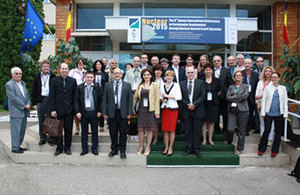Sharing knowledge internationally
We're sharing our expertise and knowledge to help other European countries develop their research plans for geological disposal.

Attendees at the PLANDIS workshop
Our experts and others have written a guide to help those countries with less advanced geological disposal programmes to meet the 2011 EC Waste Directive requirements.
The guide helps them to develop their RD&D programmes, in particular: ‘to set-out research, development and demonstration (RD&D) activities that are needed in order to implement national policies for the responsible and safe management of spent fuel and radioactive waste.’
Ray Kowe, one of our research managers, organised and led a workshop in Piteşti, Romania which was part of the EU’s Implementing Geological Disposal Technology Platform (IGD-TP). It was attended by 36 delegates from 12 countries. The workshop title was PLANning geological DISposal of radioactive waste in Europe – PLANDIS.
Ray said:
The workshop was an opportunity for new member states to gain experience of prioritising their potential research, development and demonstration work to meet their needs. They also had the opportunity to meet the more experienced RD&D planners from other countries.
We sought feedback from attendees on the usability of the guide, which is still in draft. However, we were surprised and pleased when the Hungarian implementer PURAM informed us that they had already used the guide to prepare an initial RD&D plan in their response to a new Hungarian regulation on the siting of a radioactive waste repository that came into force on June 2014.
Ray’s colleague, Steve Williams gave an overview of the EC CAST project at the workshop.
Jon Martin, our Head of Research, who takes over as the chair of the IGD-TP in 2016, said:
I was particularly delighted that many of our colleagues from European countries whose programmes are relatively new were able to learn from and network with those who have well advanced RD&D plans. It shows the value of the guide, which cites our Science & Technology Plan as an example of best practice.